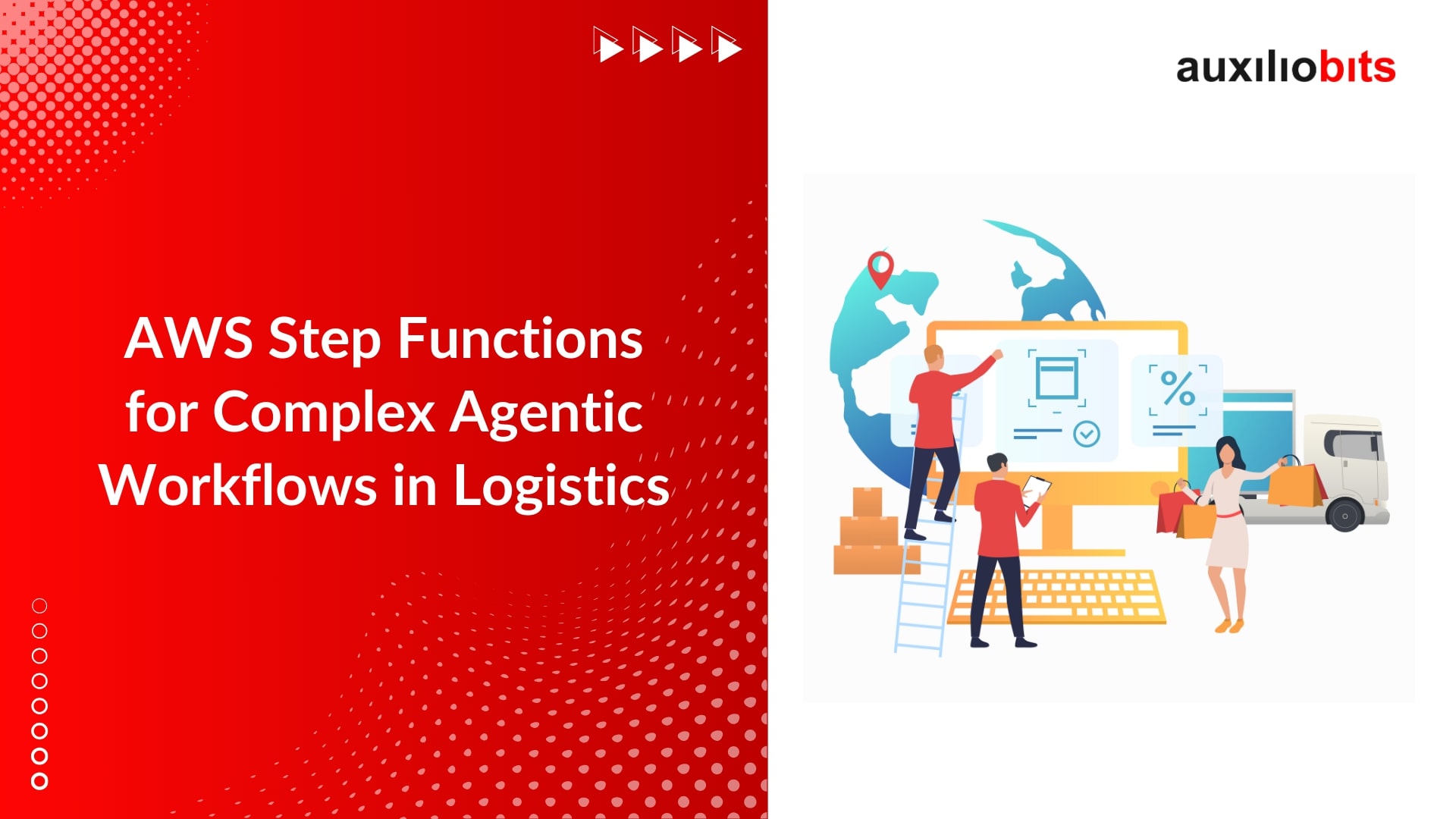
Key Takeaways
- WS Step Functions allow logistics companies to automate complex processes by integrating multiple AWS services. This automation improves task coordination, reduces human error, and ensures smoother operations across inventory management, shipment tracking, and route optimization.
- AWS Step Functions offer built-in error management features like retries, catch blocks, and fallback states. These mechanisms ensure workflow resilience, even when external services experience temporary failures, minimizing disruptions in logistics operations and enhancing reliability.
- The service easily integrates with various AWS tools such as Lambda, SQS, SNS, and DynamoDB. This native integration reduces coding complexity, making it easier for logistics companies to build scalable and efficient workflows with minimal external dependencies.
- By integrating Amazon SageMaker, AWS Step Functions can harness AI for real-time data analysis and predictive analytics. This enables logistics businesses to optimize delivery routes, forecast inventory needs, and make smarter, data-driven decisions to improve operational efficiency.
- AWS Step Functions provide a visual interface for tracking and optimizing workflows. This transparency allows logistics companies to monitor real-time progress, identify bottlenecks, and proactively address issues, ensuring smoother operations and minimizing delays in logistics processes.
How many of you agree that regular tasks in the logistics industry are daunting? In fact, working in this sector is very intimidating. From performing interconnected tasks to keeping an eye on inventory management, there is so much to do. Employees often feel exhausted while performing duties since there is so much to handle. This can lead to unwanted challenges like delays, human mistakes, and increased operational costs. Hence, we recommend implementing AWS Step Functions, which offer an innovative solution to these challenges to avoid such risks. In addition to this, it also helps enterprises develop, run, and visualize several processes with minimal coding.
AWS Step Functions can also automate end-to-end chain activities. When the stock falls below a threshold, it helps coordinate tasks such as notifying providers and checking inventory levels. Moreover, its abilities guarantee efficient shipment. Furthermore, the service support can handle mistakes and state management, ensuring reliability in operations.
Also read: Building AI Center of Excellence: Organizational Structure and Technical Capabilities
Understanding AWS Step Functions
By now, you know that AWS Step Functions removes the complexities when several AWS services coordinate. It provides a visual interface so that the workflows can be developed and monitored. That said, let us learn about the key features of AWS Step Functions. We have listed them below:
1. Ability to Handle Errors and Retries
AWS Step Functions are created with fault tolerance. It provides in-built mechanisms that can identify errors automatically. In addition to this, it also catches failures and attempts retries depending on pre-defined configurations. Developers can customize retry policies, explain error responses, and set backoff costs to ensure the operations don’t hamper. From a logistics perspective, Step Functions can automatically retry the request if an external shipment tracking API fails instead of failing the entire workflow. This allows fault-tolerant operations even when dependencies experience transient failures.
2. Parallel Execution
Step Functions’ ability to execute tasks in parallel further enhances efficiency. Parallel state configurations allow multiple tasks to run concurrently rather than sequentially, significantly reducing the overall workflow execution time, particularly in data processing or batch processing scenarios.
For instance, separate parallel tasks can check stock availability across multiple warehouses during inventory management, reducing response time and improving decision-making.
3. Service Integration
AWS Step Functions seamlessly integrate with various AWS services, including AWS Lambda, Amazon ECS, Amazon SQS, Amazon SNS, and DynamoDB. This native integration reduces the need for additional coding or third-party tools, allowing developers to build scalable and cost-effective applications.
For example, a logistics workflow can trigger AWS Lambda functions for order validation, use Amazon SQS for managing order queues, and update inventory records in Amazon DynamoDB, all orchestrated within a Step Functions state machine.
4. Workflow Visualization
A significant advantage of using AWS Step Functions is its interactive visual workflow representation. Developers can use the AWS Management Console to monitor, debug, and optimize workflows using detailed visual insights. The graphical interface provides real-time information about which steps succeeded, failed, or are in progress.
This transparency is beneficial for logistics companies managing thousands of shipments daily. With real-time monitoring, teams can proactively address workflow bottlenecks or failures, ensuring smooth logistics operations.
Architecture of AWS Step Functions for Logistics Workflows
Implementing AWS Step Functions in logistics operations involves multiple AWS services working together to streamline complex workflows. AWS Step Functions act as the central orchestration layer, ensuring seamless communication between components, managing state transitions, and providing robust error-handling mechanisms. The architecture is designed to automate and optimize key logistics tasks, including inventory management, shipment tracking, and route optimization.
Here’s a detailed look at the primary components of a typical AWS Step Functions architecture for logistics:
1. State Machine
At the core of AWS Step Functions is the State Machine, which defines the entire workflow using JSON-based Amazon States Language (ASL). The state machine consists of a series of steps, including sequential, parallel, and choice states that govern the flow of operations. It tracks the state of each task, logs progress, and ensures smooth transitions from one step to another.
For example, a logistics state machine might include states for:
- Order Validation
- Inventory Check
- Shipment Scheduling
- Route Optimization
- Shipment Tracking
- Delivery Confirmation
Each state can trigger specific AWS services or external APIs, ensuring the process moves forward without manual intervention.
2. AWS Lambda
AWS Lambda functions are critical in executing business logic within the state machine. These serverless functions can validate orders, calculate optimal delivery routes using AI models, update inventory records, and send customer notifications. Lambda functions ensure quick, scalable processing without requiring dedicated infrastructure management.
For example, if the state machine detects an inventory shortage, a Lambda function can trigger an automatic replenishment order using an external supplier API.
3. Amazon SQS and SNS
Amazon Simple Queue Service (SQS) and Simple Notification Service (SNS) provide reliable, asynchronous messaging between components. SQS ensures that messages are queued and processed without data loss, while SNS sends notifications to stakeholders like suppliers, warehouse managers, or delivery personnel.
In a logistics scenario, SQS can queue shipment status updates, and SNS can alert users in real time about critical events, such as delivery delays or successful package arrivals.
4. Amazon DynamoDB
Amazon DynamoDB serves as a high-performance, scalable database for storing logistics data. It maintains records of orders, shipment details, inventory levels, and tracking updates. Step Functions can read from or write to DynamoDB, ensuring accurate data management throughout the workflow.
For instance, DynamoDB can store real-time delivery status data, which customer service agents or logistics managers can access for immediate decision-making.
5. Amazon S3
Amazon Simple Storage Service (S3) is essential for storing large volumes of logistics-related data, including shipment logs, reports, invoices, and images. It acts as a centralized repository for both structured and unstructured data. AWS Step Functions can trigger Lambda functions to process data from S3, generate reports, or analyze shipment patterns.
For example, S3 can store GPS tracking data from delivery vehicles, which can be analyzed to optimize future routes.
6. Amazon SageMaker
Amazon SageMaker integrates seamlessly with Step Functions to provide AI-powered predictive analytics. It can analyze historical data to forecast delivery times, predict inventory shortages, or recommend optimal routes. Step Functions can invoke SageMaker models at various stages of the logistics workflow for real-time decision-making.
For instance, SageMaker can analyze weather patterns and traffic data before dispatching a shipment to predict potential delays and suggest alternate routes.
Also read: Why Is Cloud-Agnostic DevOps Key to Cross-Platform Growth?
Implementing Complex Agentic Workflows with AWS Step Functions
Implementing complex agentic workflows using AWS Step Functions enables logistics companies to automate intricate processes, optimize decision-making, and enhance operational efficiency. By orchestrating tasks across AWS services and integrating AI capabilities, Step Functions ensure seamless workflow execution. The implementation generally involves three key steps: defining the state machine, integrating with AI models, and setting up error handling and monitoring.
Step 1: Define the State Machine
The first step in implementing a logistics workflow using AWS Step Functions is to define the state machine. A state machine represents the sequence of tasks and decisions in a workflow. It is designed using Amazon States Language (ASL), a JSON-based language that defines states, transitions, and actions within the process.
Each state within the state machine can perform tasks such as checking inventory levels, validating orders, or managing deliveries. States can be of different types, including:
- Task State: Executes AWS Lambda functions or other AWS service operations.
- Choice State: Enables conditional branching based on input data, ensuring intelligent decision-making.
- Parallel State: Allows concurrent execution of tasks, optimizing processing time.
- Wait State: Pauses the workflow for a specified duration or until a defined condition is met.
- Fail and Succeed States: Provide clear workflow termination points for error management or successful completion.
Step 2: Integrate with AI Models
Integrating Amazon SageMaker with AWS Step Functions enables the incorporation of AI-powered decision-making into logistics workflows. AI models can analyze historical data to provide actionable insights for route optimization, delivery time estimation, and inventory forecasting tasks.
During the workflow execution, Step Functions can invoke AI models hosted on SageMaker to generate predictions in real time. For instance, predictive models can assess traffic patterns, weather conditions, and route preferences to recommend the most efficient delivery routes. Similarly, AI algorithms can monitor inventory levels and forecast demand to prevent stockouts or overstocking. This AI integration allows logistics companies to make data-driven decisions, enhancing operational accuracy and responsiveness.
Step 3: Error Handling and Monitoring
Error management is critical when implementing complex workflows. AWS Step Functions provide built-in error handling with mechanisms like Retries, Catch Blocks, and Fallback States. These features ensure that the workflow remains resilient despite failures, minimizing disruptions.
- Retries: Step Functions can automatically retry failed tasks based on customizable parameters such as maximum retry attempts and backoff rates. This is particularly useful when dealing with transient errors or network issues.
- Catch Blocks: Catch blocks can capture specific error types, allowing the workflow to handle errors gracefully. For example, Step Functions can execute alternative actions like notifying stakeholders or triggering backup workflows if an external API call fails.
- Fallback States: In case of critical failures, workflows can transition to fallback states that initiate recovery processes or log error details for further investigation.
Additionally, integrating AWS Step Functions with Amazon CloudWatch ensures real-time monitoring and logging. CloudWatch tracks workflow progress, logs errors, and provides alerts for any anomalies, enabling proactive issue resolution. By visualizing workflow execution in the AWS Management Console, teams can quickly identify and resolve performance bottlenecks.
In Conclusion
Implementing complex agentic workflows with AWS Step Functions helps logistics companies automate decision-making, improve process visibility, and enhance overall operational efficiency. Organizations can streamline logistics processes and ensure reliable, scalable performance by defining robust state machines, integrating AI-driven predictive models, and using advanced error management and monitoring.
For more details, feel free to contact us at Auxiliobits. We will be more than happy to serve you.








